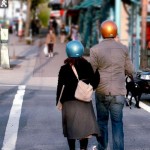Recently, I discovered that the City of Ottawa uses anonymized, aggregated Strava data as a data source for determining where bicycle infrastructure is needed. Although the National Capital Commission has established a good network of recreational pathways in and around Ottawa, we desperately need more safe streets for people who ride bikes for regular transportation.
Apparently there is some way that adjustments are made to accommodate for the fact that most cyclists don’t use Strava or other tracking apps. I don’t understand all the science behind it, but I know just enough about statistics to know that sample bias is an issue, and I know that most of the people who use Strava are athletic types tracking longer rides. People using their bikes for short trips to do everyday chores may not use Strava at all, or not think to turn it on because it doesn’t “count”.
Since I’m a big advocate of cycling for everyone, I have started tracking every single ride, no matter how short. My aim is to mess with the city by skewing the data as much as possible in favour of shorter utilitarian trips, and show where better infrastructure is needed.
How am I messing with myself? Since I started tracking faithfully on April 17, I have racked up just over 105 km. I have become the local legend on segments leading to my work. My speed is trending downwards and I have set a couple of personal best times.
I have also become more determined than ever to bike everywhere possible, and my definition of what is possible has gotten bigger. Two of those rides were unusually long for me, but turned out to be perfectly manageable: one was a 13 km ride from the blood donor clinic, and the other was 15 km to and from Costco.
The blood donor ride was fun as I got to explore quirky neighbourhoods full of small businesses that I find hard to get to by public transit. I even rode across the bridges to and from Gatineau, the best part of my commute when I worked over there.

That Costco ride was an important stepping stone for me. The routes proposed by Google were all along busy roads but I remembered quieter recreational paths that made for a longer but safer ride. However, I did need to navigate one notoriously busy road with unclear painted bike lane markings (and only 1 block of protected lane).
Costco itself had the usual car-filled parking lot and the bike racks were way in the back of the building, so I locked up to a sign near the front. It was easy to pack everything into two panniers, and I didn’t need the bungee cords, extra bags and my knapsack I had brought along just in case I felt the need to train for the #carryshitolympics. Now I know that a mostly-pleasant half hour ride each way is all it takes to get to a store I generally avoid.























